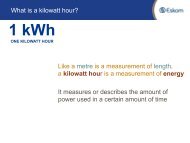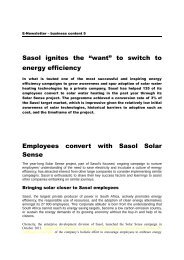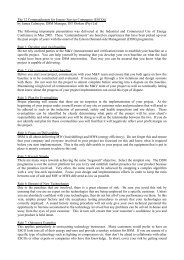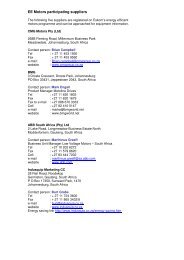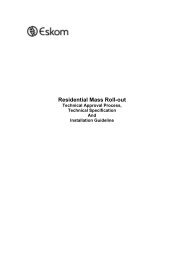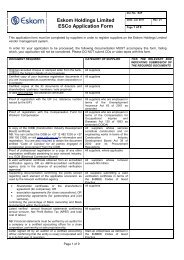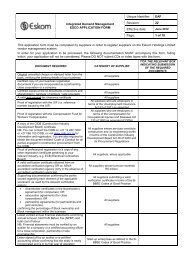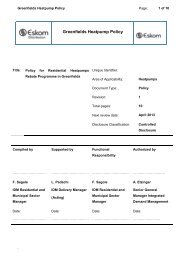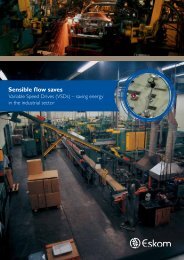CFL Recovery, Recycling & Disposal Implementation ... - Eskom IDM
CFL Recovery, Recycling & Disposal Implementation ... - Eskom IDM
CFL Recovery, Recycling & Disposal Implementation ... - Eskom IDM
You also want an ePaper? Increase the reach of your titles
YUMPU automatically turns print PDFs into web optimized ePapers that Google loves.
Roles and Responsibilities1Distinct roles and responsibilities arise for all stakeholders conducting any management activities related toboth the disposal of spent <strong>CFL</strong>s to a hazardous landfill (short-term intervention) or to a recycling facility (longtermintervention).The short-term interventions include separation at source, drop-off centres, collection, storage and treatment,then transportation to a hazardous landfill for disposal, as an immediate solution. Long-term interventions,which in time should replace short-term activities, will instead of disposal require the recycling of asmany of the constituent materials of the spent <strong>CFL</strong>s as possible and setting out the relevant responsibilities.Each of these steps is set out on the next page, and the key roles and responsibilities of the partiesconcerned with the managementof spent <strong>CFL</strong> waste, are discussed.How to use this documentThe steps and activities for safe management of <strong>CFL</strong> waste, fromseparation at source to ultimate disposal at a hazardous landfillsite or to a recycling facility, are outlined in the various sectionson the next page. Each section is colour-coded in accordance withthe specific identifying icon, for ease of reading. Within each of the‘steps’ the various stakeholders involved and their responsibilitiesare tabulated separately.As an EXAMPLE, a representative from a local municipalityinterested in initiating retail drop-off centres in the municipalarea would:STEP 1: Identify from the list of icons (refer cover page) the relevantone for drop-off centres.STEP 2: The blue-grey colouring of the identified iconindicates the colour of the section of the document that deals withdrop-off centres.STEP 3: Locate within the identified section tabulated guidelinesspecific to a local municipality.127029ESKD <strong>CFL</strong> Brochure.indd 12010/06/03 9:29 AM
<strong>CFL</strong> Waste ManagementAn overview of the chain of activities that forms part of the management of <strong>CFL</strong> waste, from point of generation at the household to eventualdisposal or recycling, is summarised at a high level below. Further detail and clarification of concepts are covered in the respective subsections(refer colour-coded sections) of this guide.MinimumRequirementNo <strong>CFL</strong>s to generallandfillNo mercury releasedin transportNo mercuryreleased in storageNo mercuryreleased in transportNo mercury releasedNo mercury releasedNo mercury releasedand no contaminatedcomponents<strong>Implementation</strong>GuidelineSafe keeping toprevent breakageSuitable containerto prevent breakageSafe intermediatestorageSafe bulktransportationin suitable containersEnvironmentallysoundpractice/technologyEnvironmentallysoundpracticeEnvironmentallysoundpractice/technologyRoles andResponsibilitiesConsumer/HouseholderConsumer/HouseholderAuthoriseddrop-off centreowner/managerAuthorisedtransporterAuthorised serviceproviderLicensed facilityowner ormanagerLicensed facilityowner ormanagerRelevantLegislationRelevant bylaws,NEMA and Waste BillRefer separatelegislativeoverviewRefer separatelegislativeoverviewRefer separatelegislative overviewRefer separatelegislative overviewRefer separatelegislative overviewRefer separatelegislative overviewCommunicationRequirementsExtensive general education and awareness regarding waste and recycling. Specific communication support including labeling of packaging and clear signageof premises. Collaboration and integration with relevant stakeholders are essential.M&VRequirementsNoneNoneType and volumesreceivedVolumestransportedVolumes treated Volumes landfilled Volumes recycledNot required Not required Required Required Required Required Required* Indication of the responsibilities and involvement foreseen for a funding and administration oversight entity Hg = mercury127029ESKD <strong>CFL</strong> Brochure.indd 22010/06/03 9:29 AM
Keeping <strong>CFL</strong>s out of the general waste bin3The outgrowth of conservation,the inevitable result, is national efficiency.- Gifford Pinchot127029ESKD <strong>CFL</strong> Brochure.indd 32010/06/03 9:29 AM
Industry ResponsibilityA communication strategy is part of the requirements of an Industry Waste Management Plan as describedin the Waste Management Bill (pending enactment, expected early 2009). Any Industry Waste Managementplan for fluorescent lamps would rely heavily on participation, and hence the awareness of homeowners.The lighting industry would therefore have an obligation to collaborate with other stakeholders in creatingawareness and educating the public about waste separation.Separationat sourceIndustry activitySelect industr y player s areactively addressing lighting wasteinternationally and some havealready taken an active lead inthe <strong>CFL</strong> recovery efforts in SouthAfrica. You can obtain informationfrom these suppliers directly orread more on their websites:IndustryObjectiveLegislationBest PracticePrevent the disposal of <strong>CFL</strong>s and otherfluorescent lamps with other householdswaste in order to facilitate recovery.Industry’s involvement will be mosteffectively governed under the pendingWaste Management Bill, a subset of theNational Environmental ManagementAct (NEMA).<strong>CFL</strong> packaging should be labeledappropriately to educate consumersregarding mercury content and handlingof <strong>CFL</strong> waste.Additional InformationAlthough the Extended Producer Responsibility principle is alreadyentrenched in existing legislation, the enactment of the WasteManagement Bill and a Government request for an IndustryWaste Management Plan will force active industry involvementwith lighting waste.Different graphics with supporting text could be used to educate theconsumer about mercury content and requirements for safe disposalor recycling as appropriate. Labels should be clearly visibleand understandable.Philips: +27 (0)87 940 4194or +27 (0)11 471 5065or www.philips.com/about/sustainability/recyclingor refer to page 14 for others.What todo with <strong>CFL</strong>sCall centre details to be provided onpackaging and call centres should beempowered to deal with enquiries relatingto safe disposal and handling of <strong>CFL</strong> waste.Labeling should ideally highlight theopportunity for re-use of packaging material(assumed optimal format to preventbreakage of lamps).A collaborative effort among lighting suppliers can address all thesecalls or alternatively existing call centres can be briefed to dealwith these questions.Consumers should be encouraged to re-use packaging material for safestorage and transport of spent <strong>CFL</strong>s.127029ESKD <strong>CFL</strong> Brochure.indd 62010/06/03 9:29 AM
Department of Environmental Affairs and Tourism (DEAT) Responsibility7National Government support for a nationwide <strong>CFL</strong> recovery mechanism is critical to the success of theinitiative. More generally, the encouragement of separation at source will promote the shift towards moresustainable waste management strategies and practices, and place emphasis on the reduction, re-use andrecycling of wastes:DEATObjectiveLegislationWhere toenforceseparationat sourceHow tosupportseparationat sourceBest PracticeAdditional InformationTo encourage thorough legislation andregulations and to enforce separation atsource of all recyclable and particularlyhazardous household waste.DEAT’s involvement is governed by thenational legislative framework including:the Constitution, National EnvironmentalManagement Act and MunicipalSystems Act.Encourage and support the inclusion of theconcept into Municipal Integrated WasteManagement Plans and the development ofbylaws to enforce separation at sourceby homeowners.Separation at source is an essential component of all recycling initiativesand should be widely encouraged.Emphasis should be placed on the importance of appropriate handlingof hazardous household waste among all role players and every entityunder legal obligation to comply.A national education campaign. Generaleducation must be provided to theOverall education relating to waste, recycling and hazardous householdpublic to improve their knowledge of thewaste has been identified during public consultation as an imperativeimpact of mercury bearing lamps onsince existing awareness levels are extremely low. Education with regardthe environment. Support should also beto the benefits of using energy saver lamps should also form partprovided to provincial departments andof communications.local municipalities in the form of informationsharing, education and empowerment.Communication support Comprehensive and collaborative communication, education andawareness support is required by all stakeholders, including: package labeling; municipal communicationthrough all available media including billing runs and a national education and awareness campaign.Separationat sourceRelevant contactsRelevant DEAT Directorates andcontacts include, among others:1. Directorate:Waste Stream Management,Ms Dee Fisher+27 (0)12 310 3527,dfisher@deat.gov.za2. Directorate:Waste Policy & InformationManagement, Mr Obed Baloyi+27 (0)12 310 3833,obaloyi@deat.gov.za127029ESKD <strong>CFL</strong> Brochure.indd 72010/06/03 9:29 AM
Delivery of <strong>CFL</strong>s at Collection Points127029ESKD <strong>CFL</strong> Brochure.indd 82010/06/03 9:29 AM
Consumer Responsibility9In the absence of a separate sidewalk collection service, consumer participation will necessarily includetransportation of <strong>CFL</strong>s to a local collection point. This is aligned with international practice whereresidential consumers are generally required to deliver spent <strong>CFL</strong>s and other hazardous household wastes(e.g. batteries) to central locations including participating retailers and collection bins. Suggested practicesfor safe transportation are provided below:ConsumerObjectiveLegislationHow totransportyour <strong>CFL</strong>sWhat if<strong>CFL</strong>s breakduring transitBest PracticeTo ensure safe transportation of spent <strong>CFL</strong>sto a drop-off centre or mobile unit.Minimum Requirements for HazardousWaste <strong>Disposal</strong>, National Transportation Act.Ideally <strong>CFL</strong>s should not be broken duringtransit. <strong>CFL</strong>s must be transported carefullyin a manner that will prevent breakage andminimise the risk to handlers for delivery toa suitable disposal or collection point.If during transit a <strong>CFL</strong> does break, openyour windows immediately and pull over atthe nearest safe location. Once air has beencirculated, put <strong>CFL</strong> in a plastic bag and dropoff at the nearest drop-off centre.Additional InformationUsually applicable to bulk carriers of hazardous materials. Safekeeping of small quantities to prevent breakage required.It is suggested that <strong>CFL</strong>s be placed in their original packaging or emptypackaging of replacement lamps or wrapped in a sealable (heavy/thick)plastic bag. Transport household hazardous waste in the rear ofthe vehicle, ideally packed securely in the vehicle to prevent crushingand do not store in the vehicle for extended periods.Also wipe the car with a damp cloth and dispose of any remainingglass fragments at your earliest convenience. Containment of thelamps in a plastic bag will contain any pieces and will greatly simplifythe cleaning up.PrivateTransportationRelevant contactseWaste service providersand recycling companiesprovide collection services thatsometimes include hazardoushousehold waste. Ser viceproviders or participants inyour area may be listed with:1. eWASA (National):+27 (0)11 312 3605or www.ewasa.org2. Urban Sprout Eco-Directory:www.urbansprout.co.za3. Faithful to NatureEco-Directory:www.faithful-to-nature. co.za/directory127029ESKD <strong>CFL</strong> Brochure.indd 92010/06/03 9:29 AM
Muncipal ResponsibilitySmall scaleTransportationMobile UnitsThe use of mobile units is asolution employed internationallywhich makes use of mobilecontainers that collect hazardoushousehold waste from residentialareas on a regular basis. Feasibleimplementation is dependent onprovision of the service for abroad range of hazardous wastetypes to benefit from economiesof scale and logistical synergies.Where separate collection services for household hazardous waste are not provided, collection days orcollection events held regularly at suitable locations have become very popular among local municipalitiesinternationally. Municipalities have implemented pilot studies for separate sidewalk collection services ofselect wastes, including recyclables, across South Africa. The following guideline is therefore aimed at guidingany municipalities that do get involved in the collection and transport of household hazardous waste,including <strong>CFL</strong>s.MunicipalityObjectiveLegislationHow totransport<strong>CFL</strong>sBest PracticeTo ensure safe transportation of spent <strong>CFL</strong>sto a drop-off centre or mobile unit.Minimum Requirements for Hazardous Waste<strong>Disposal</strong>, National Transportation Act.A municipality may be involved in thetransportation of spent <strong>CFL</strong>s by implementing acontract with a private company. It is essential thatthe private company makes use of specific crateswhich prevent the breakage of spent <strong>CFL</strong>s.Vehicles must be roadworthy and appropriateand in accordance with the National Traffic Act(GNR. 225) requirements.The applicable TREM decals must be displayed onthe vehicles and provide correct details.The driver(s) of the vehicle(s) must be qualified,trained and hazardous waste certified to transporthazardous goods.In the event of breakage or spillage, all personnelmust leave the vehicle immediately and contactthe incident team. Personnel must wearPersonal Protective Equipment (PPE) at all times.Additional InformationUsually applicable to bulk carriers of hazardousmaterials. Safe-keeping of small quantities to preventbreakage is required.Spent <strong>CFL</strong>s must be transported in such a manner thatthe breakage of <strong>CFL</strong>s is prevented and that, in the caseof breakage, no mercury leakage emanates from thetransportation containment.127029ESKD <strong>CFL</strong> Brochure.indd 102010/06/03 9:29 AM
Waste Contractor Responsibility11Environmental consciousness is intensifying and, particularly among high-income households and in urbancentres, the demand for collection services for recyclable material has resulted in seemingly sustainablebusiness opportunities. In select instances service providers are extending the collection offering to includehousehold hazardous wastes such as batteries, etc. The following framework is therefore aimed at guidingany private waste/recyclables collection contractors that do get involved in the collection and transport ofhousehold hazardous waste, including <strong>CFL</strong>s.Waste Collection ContractorBest PracticeObjectiveLegislationHow totransport<strong>CFL</strong>sTo ensure safe transportation of spent <strong>CFL</strong>s to a dropoffcentre or mobile unit (or other appropriate storageor treatment facility).National Transportation Act, Minimum Requirement forHazardous Waste <strong>Disposal</strong>.If a private waste contractor would like to be involvedin the transportation of spent <strong>CFL</strong>s, it is essential thatspecific crates which prevent the breakage of spent<strong>CFL</strong>s be used.Vehicles must be roadworthy and appropriate and inaccordance with the National Traffic Act (GNR. 225)requirements.The applicable TREM decals must be displayed on thevehicles and provide correct details.The driver(s) of the vehicle(s) must ideally be qualified,trained and hazardous waste certified to transporthazardous goods.In the event of breakage or spillage, all personnel mustleave the vehicle immediately and contact the incidentteam. Personnel must wear Personal ProtectiveEquipment (PPE) at all times.Additional InformationService providers may cut out the collection points andtransport <strong>CFL</strong>s directly to a storage or treatment facility.In that case please refer directly to bulk transport andwaste treatment and storage implementation guidelines.Usually applicable to bulk carriers of hazardous materials.Safe keeping of small quantities to prevent breakageis required.Suitable packaging and containers/crates are particularlyimportant if transported with other wastes that can crushthe <strong>CFL</strong>s in transit.If very small quantities are transported with otherwastes, it is recommended that the driver is at leasttrained to deal with breakages or spillage of hazardousmaterials including <strong>CFL</strong>s.Ensure ventilation of the area of breakage and ensurea spill kit is available. A single breakage can be cleanedup and addressed as for a private vehicle (refer toconsumer guideline).PrivateTransportationRelevant contactsNo ser vice provider s arecurrently known to providecollection services for <strong>CFL</strong>s fromhouseholds, but service providersthat collect from commercialproperties may be available toassist at a fee.The following service providersare active in the commercialmarket:1. Nova Lighting2. Lumino3. ActebisRefer to Treatment Section of thisguideline for the contact details.127029ESKD <strong>CFL</strong> Brochure.indd 112010/06/03 9:29 AM
Hosting <strong>CFL</strong> Collection Points/Drop-off Centres127029ESKD <strong>CFL</strong> Brochure.indd 122010/06/03 9:30 AM
Consumer Responsibility13The sustainability of a collection point network for spent <strong>CFL</strong>s in South Africa is dependent on the levelof participation by the public. South Africans are therefore encouraged to make use of the facilities providedby retailers and any other participants and also to use these facilities responsibly.The practices described below are therefore aimed at guiding participation by consumers.Consumer ResponsibilityBest PracticeObjectiveLegislationHow to usea drop-offcentreSafely deposit all failed <strong>CFL</strong>s atparticipating collection pointsor drop-off centres.Minimum Requirements forHazardous Waste <strong>Disposal</strong>,any relevant municipal bylaws.Deliver <strong>CFL</strong>s intact toparticipating collection pointsor drop-off centres anddeposit into the dedicatedcontainer provided.<strong>CFL</strong> SelectionThe choice of a new <strong>CFL</strong> requiressome consideration:- Required brightness of the light(represented by the wattage).- The desired colouring of the lamp (representedby the Kelvin value and described as eitherAdditional InformationIdeally the spent <strong>CFL</strong> should arrive unbroken and in its original packaging orwrapped/sealed in a plastic bag. Deposit <strong>CFL</strong>s into the collection bin which shouldbe clearly marked and secure unless specifically instructed otherwise at the specificdrop-off centre. Handle spent <strong>CFL</strong>s carefully to prevent breakage. Children shouldbe kept away from the collection bins and discouraged to play with or aroundthese facilities. Replace failed <strong>CFL</strong>s with a suitable replacement.warm white or cool white) or alternatively canbe coloured lighting/glass, such as red or blue.- The appropriate fitting i.e. screw-in or bayonet.- Whether the lamp should be dimmableor not and whether it should functionwith a motion sensor (often requiredfor external or security applications).Drop-offCentresRelevant contactsThe following collection points areavailable to consumers wantingto participate:1. Pick ‘n Pay stores nationwide.Contact Pick ‘n Pay for yourclosest store on+27 (0)800 11 22 88or visit their website:www.picknpay.co.za2. Select Woolworths storesnationwide. ContactWoolworths for participatingstores on +27 (0)860 100 987or visit their website:www.woolworths.co.za127029ESKD <strong>CFL</strong> Brochure.indd 132010/06/03 9:30 AM
Drop-off Centre/Collection Facility ResponsibilityThe responsibilities and requirements relevant to hosting a collection facility or drop-off centre arefairly significant but mainly require sensible caution, similar to that necessary for handling a wide varietyof household hazardous goods (e.g. paint, poisons, batteries, etc.) generally sold by retail and hardwarestores. A detailed guideline is provided below to guide anyone interested in hosting a collection point ordrop-off centre.Drop-offCentresPermissible storageCurrent legislation requires:1. Permitting of a collection/drop-off facility to actas a temporary wastestorage facility.2. At least a Basic Assessmentis done towards a full EIA.Indications from DEAT are thatthe Waste Management Act andrelated regulations will makeallowance for temporary storageand recovery activities handlingsmall quantities of hazardouswaste to be exempted from therequirements for a license(see page 18 for details).Drop-off Centre FacilitiesBest PracticeTo host a clearly marked and safe drop-off facility.To ensure that <strong>CFL</strong>s are temporarily stored in a mannerthat is not harmful to the individual housholder, the publicObjective or the environment.To provide a convenient point for the consumer to return theirspent <strong>CFL</strong>s.To provide a permanent or temporary point for wastetransporters to collect spent <strong>CFL</strong>s en masse.LegislationWhat isrequired ofthe facility?Minimum Requirements for Hazardous Waste <strong>Disposal</strong> newEIA Regulations.A suitable container of sufficient size that can safely accommodatethe volumes of <strong>CFL</strong> waste dropped off.A sufficient area of floor space to accommodate the containerand to allow access and ventilation if required.Drop-off containers should be positioned in a prominent andeasily accessible location that is clearly marked.Additional overflow storage capacity needs to be provided bydrop-off centre hosts for the safe storage of full containers.The correct permit/license or exemption from such a licensemust be obtained where applicable (i.e. where waste volumesexceed the permissible concentrations and maximumallowed weights).Additional InformationIt is anticipated that drop-off points will form part of anever expanding network of <strong>CFL</strong> collection infrastructure.Refer to the legal overview for specific acts, clauses andregulations of interest.Typically a minimum of 1m 2 space is required.Location in a store would ideally be either at the salespoint for new <strong>CFL</strong>s, at the till or close to the exit as partof a “recycling street” that also enables consumers toreturn other waste items such as plastic bottles etc.Additional storage is required to accommodate anydelays for the pick-up of the spent <strong>CFL</strong>s by specialisedtreatment, disposal or recycling service providers.Whilst there is ongoing engagement with DEAT toresolve possible exemptions, it is suggested that in theinterim, facilities are managed responsibly in accordancewith these guidelines.127029ESKD <strong>CFL</strong> Brochure.indd 142010/06/03 9:30 AM
Drop-off Centre/Collection Facility Responsibility15Drop-off Centre FacilitiesBest PracticeThe collection point should preferably onlyaccept intact <strong>CFL</strong>s and no breakage shouldoccur during the drop-off or temporarystorage process.Quantities of <strong>CFL</strong> waste collected and storedmust be safely manageable at all times.Collection points must be clearly demarcatedand labelled and containers must be labelledwith clear instructions on the type oflamps accepted and how the lamps haveto be returned.How tomanage adrop-offcentreHow tosafelystore <strong>CFL</strong>sAdditional InformationThe public and employees of the collection facility should be educated.Regular emptying of containers to avoid overflow and thus breakageand regular removal from collection points is strongly recommended.Communication, education and awareness creation are critical. Everyopportunity should be used to encourage participation and to remindthe public to drop off unbroken <strong>CFL</strong>s, preferably in original packagingor wrapped/sealed in a suitable plastic bag.The temporary storage area for full containersmust be safe and easily accessible when lampsare picked-up.Collection frequency must be commensurate Collection frequency can either be based on an actual needs basewith the volumes of <strong>CFL</strong> waste actually dropped (when bin is full) or can be at regular intervals throughout the collectionoff and generated within the retail store. period (e.g. every fortnight).The drop-off centre/collection facility may notbe left unattended at any time. At least oneemployee should be present on site/in-storeand should be identified as the individualresponsible for <strong>CFL</strong> collection.Containers must be inspected regularlyfor level and other problems e.g. mercurycontamination from broken bulbs and theiroverall functionality.Drop-off centres cannot take the format of a glass bank left unattendedin a parking area. The delegated responsibility is particularly important inthe case of spillage or breakage.Drop-offCentresRelevant contactsHazmat provides a national24-hour spill response service.Hazmat can be contacted incaseof emergency toll free at:0800 00 58 17 or for enquiriescontact the head office at+27 (0)33 386 2264or email: ian@hazclean.co.zaAlternatively visit their website at:www.24hourspillresponse.co.za.127029ESKD <strong>CFL</strong> Brochure.indd 152010/06/03 9:30 AM
Industry ResponsibilityThe voluntary initiation of <strong>CFL</strong> collection points by retailers in South Africa is an important step towards anational <strong>CFL</strong> recovery network. Maintaining the momentum created by these initiatives should be a priorityfor all stakeholders, including the lighting industry.Drop-offCentresPermissible storage(Continued from page 15)Lighting suppliers that havedemonstrated commitment tothe management of the fullproduct life cycle of <strong>CFL</strong>s,locally or globally:1. Osram: www.osram.co.zaOperating collection centres will constitute a key component of a functional Industry Waste ManagementPlan and hence would be of particular interest to the lighting industry.It is not expected that industry players will host their own drop-off points but should any lighting supplierbe interested in hosting such a facility, the guidelines for drop-off facilities (refer to preceding section) willbe relevant. The guideline below is aimed at industry in their role as supporter of drop-off centres.IndustryObjectiveLegislationBest PracticeAdditional InformationSupport the establishment of safe, convenient andlegally compliant drop-off centres that will facilitate therecovery of <strong>CFL</strong>s.Ensure the sustainability of drop-off centre for <strong>CFL</strong>s.Minimum Requirements for Hazardous Waste<strong>Disposal</strong> new EIA regulations, Waste Management Bill.Refer to legal overview for specific acts, clauses andregulations of interest.2. Eurolux: +27 (0)21 528 8400or +27 (0)11 608 2970www.eurolux.co.zaHow tosupportdrop-offcentresAssist with creating public awareness in terms of <strong>CFL</strong>drop-off centres.Support the establishment of safe, convenient andlegally compliant drop-off centres that will facilitatethe recovery of <strong>CFL</strong>s.Encourage the use of drop-off centres.Financial, logistical and administrative support are all requiredto ensure a sustainable solution.Several oportunities arise such as linked sales promotionsand discounts on replacement <strong>CFL</strong>s linked to the returnof failed lamps.127029ESKD <strong>CFL</strong> Brochure.indd 162010/06/03 9:30 AM
Local Muncipality Responsibility17Hosting of a drop-off facility for <strong>CFL</strong>s at council premises would follow the same guidelines as for otherdrop-off facilities (refer to preceding section for drop-off centres). The guideline below is to assist localmunicipalities interested in having collection points established in the municipal area.Local MuncipalityBest PracticeSupport the establishment of safe, convenient andlegally compliant drop-off centres that will facilitate therecovery of <strong>CFL</strong>s in municipal areas.ObjectiveLegislationHow toget facilities for<strong>CFL</strong>collectionHow tosupportdrop-offpointsEncourage participation by residents in themunicipal area.Prevent the disposal of <strong>CFL</strong>s in general landfills.Municipal Systems Act, Minimum Requirements forGeneral Landfill.The municipality may host <strong>CFL</strong> drop-off facilities at suitablemunicipal premises.Engage local retailers or other suitable facilities to host<strong>CFL</strong> drop-off centres.Assist with education and creation of public awarenessregarding the need for and participation in <strong>CFL</strong> drop-offcentres. Empower interested participants.Additional InformationPossible options for collection points include utility offices,public libraries, community centres or manned refusedrop-off centres.Hardware stores, lighting suppliers, general retailers,24-hour convenience stores at petrol stations can all beconsidered for participation.Communicate details of participating drop-off facilitiesin municipal publications and communications.International experienceIn the US, local governments havereached out to local retailers tohost collection points. Informationand examples of bins, posters andcollection points can be found onthe websites of:- IKEA- Wal-Mart- Sears Stores- Ace Hardware- Home DepotDrop-offCentres127029ESKD <strong>CFL</strong> Brochure.indd 172010/06/03 9:30 AM
Department of Environmental Affairs and Tourism (DEAT) ResponsibilityA national recovery network for <strong>CFL</strong>s via central collection points is a significant improvement on the statusquo where all <strong>CFL</strong>s are disposed of at the general landfill. A simplified mechanism or possibly exemptionfrom EIA requirements and waste facility licensing with consideration of the tools established underthe pending Waste Management Act, is strongly recommended. Support and voluntary involvement byretailers and other collection points are needed to govern the collection mechanism as a whole.Drop-offCentresEnabling/SupportingLegislationTwo onerous legislativerequirements will prohibit theparticipation of retailers andothers in establishing acomprehensive recoverymechanism for <strong>CFL</strong>s.Indications from DEAT arethat new waste regulations will,in future, partly address thetemporary storage constraintsbut EIA requirements will haveto be aligned to facilitate andencourage recovery, responsiblehandling and recycling of <strong>CFL</strong>s.DEATObjectiveLegislationHow tosupport <strong>CFL</strong>collectionBest PracticeTo encourage the use of drop-off centresand to support drop-off centres.Minimum Requirements for HazardousWaste <strong>Disposal</strong>, new EIA regulations.Exemption should be considered andsupported for the listed activity as perregulation 386: The temporary storageof hazardous waste.Request/enforce (as appropriate) thedevelopment of a Lighting Industry WasteManagement Plan.Additional InformationA formalised and appropriately managed collection mechanism for<strong>CFL</strong>s is a significant improvement on the status quo.Emphasis should be placed on the importance of appropriate handlingof hazardous household waste among all role players and everyentity under legal obligation to comply. Alignment of EIA and WasteManagement requirements to support <strong>CFL</strong> recovery is essential.Whilst relaxation is proposed, alternate mechanisms such as anIndustry WMP is required to ensure that <strong>CFL</strong> recovery is structuredand responsible through a formal waste management plan and anoversight/audit function.Communication Support Comprehensive and collaborative communication, education and awarenesssupport is required by all stakeholders, including:• Clear demarcation, signage and branding of collection points. • Package labeling. • Guidelines for facilityuse (pamphlets, posters and signage). • Muncipal communication through available media includingbilling runs. • Education and awareness campaign among Muncipal residents. • National education andawareness campaign.127029ESKD <strong>CFL</strong> Brochure.indd 182010/06/03 9:30 AM
Bulk Transportation1919127029ESKD <strong>CFL</strong> Brochure.indd 192010/06/03 9:30 AM
Waste Contractor ResponsibilityWaste contractors that are required to collect <strong>CFL</strong>s from drop-off centre facilities should take cognisanceof the hazardous nature of <strong>CFL</strong>s and the requirements for handling and transportation. The need for wasteinformation management and tracking is also introduced at this stage of waste handling. These guidelinesare aimed at assisting with best practice for bulk transport of <strong>CFL</strong>s.Bulk transportationRelevant contactsNo service providers are currentlyknown to provide collection servicesfor <strong>CFL</strong>s from households,but service providers that collectfrom commercial propertiesmay be available to assist at a fee.The following service providers areactive in the commercial market:1. Nova Lighting2. Lumino3. ActebisRefer to Treatment Section forcontact details.Waste ContractorBest PracticeObjective To ensure safe transportation of spent <strong>CFL</strong>s to a landfillsite or recycling facility.LegislationHow totransportyour <strong>CFL</strong>sMinimum Requirements for Hazardous Waste <strong>Disposal</strong>,National Transportation Act.If a private waste contractor would like to be involved inthe transportation of spent <strong>CFL</strong>s it is essential that specificcrates which prevent the breakage of spent <strong>CFL</strong>s be used.Vehicles must be roadworthy and appropriate andin accordance to the National Traffic Act(GNR. 225) requirements.The applicable TREM decals must be displayed on thevehicles and provide correct details.The driver(s) of the vehicle(s) must be qualified, trained andhazardous waste certified to transport hazardous goods.In the event of breakage or spillage all personnel mustleave the vehicle immediately and contact the incidentteam. Personnel must wear PersonnelProtective Equipment (PPE) at all times.Additional InformationSpent <strong>CFL</strong>s must be transported in such a manner thatthe breakage of <strong>CFL</strong>s is prevented and that in the caseof breakage no mercury leakage emanates from thetransportation containment.Ensure ventilation of the area of breakage and ensurea spill kit is available. A single breakage can be cleanedup and addressed as for a private vehicle (refer toconsumer guideline) Hazmat provides 24-hour spillresponse in the case of an accident or serious spill of largevolumes of <strong>CFL</strong>s. Contact details for Hazmat must beprovided to drivers (refer to page 13 for contact details).127029ESKD <strong>CFL</strong> Brochure.indd 202010/06/03 9:30 AM
Municipal or Industry Responsibility21Should either municipalities or industry be interested in, or be required to, collect <strong>CFL</strong>s from drop-off centre facilities, the requirements forhandling and transportation of <strong>CFL</strong>s as per the guidelines for a Waste Contractor will apply. As for waste contractors, the need for wasteinformation management and tracking is a requirement introduced at this stage of <strong>CFL</strong> waste handling and should be given due consideration. Itis also possible that municipalities and industry players may be involved in the recruiting of waste contractors for a collection and transportationservice. These guidelines are therefore aimed at assisting with appropriate practice when contracting for bulk transport of <strong>CFL</strong>s.Local Municipality or IndustryBest PracticeObjectiveTo ensure safe transportation of spent <strong>CFL</strong>s to a landfill site or recycling facility.Additional InformationLegislationMinimum Requirements for Hazardous Waste <strong>Disposal</strong>, NationalTransportation Act.Verify that the contractor complies with the Best Practices described in thepreceding guideline. This will include having suitable crates which prevent thebreakage of spent <strong>CFL</strong>s.Spent <strong>CFL</strong>s must be transported in such a manner that the breakageof <strong>CFL</strong>s is prevented and that in the case of breakage no mercury leaks fromthe transportation containment.Vehicles are roadworthy and comply with the National Traffic Act(GNR. 225) requirements.What to considerwhen contractingfor thetransportationof <strong>CFL</strong>sApplicable and accurate TREM decals are displayed on the serviceprovider’s vehicles.Confirm that driver(s) of the vehicle(s) are qualified and are certifiedto transport hazardous goods.Check that drivers are trained to deal with emergency situations andthat all personnel handling the hazardous waste wear Personal ProtectiveEquipment (PPE).Ensure that the transport contractor captures the waste data and submitscompleted records and reports to all relevant entities including yourself and theFund administration entity.127029ESKD <strong>CFL</strong> Brochure.indd 212010/06/03 9:30 AM
Department of Environmental Affairs and Tourism (DEAT) ResponsibilityThe primary requirement for National Government involvement with transportation is for the relaxationof the legal requirements for transporting select ‘hazardous’ waste types so as to facilitate recovery andresponsible handling.Bulk transportationDEAT Contact detailsDirectorate: Pollution& Waste Management:Mr Rantsadi Moatshe+27 (0)12 310 3648rmoatshe@deat.gov.zaDirectorate: Authorisation& Waste <strong>Disposal</strong> Management:Ms Kellelo Ntoampe+27 (0)12 310 3920kntoampe@deat.gov.zaDEATObjectiveLegislationWhere toenforceseparationat sourceHow tosupportseparationat sourceBest PracticeTo encourage thorough legislation and regulations.The separation at source of all recyclable, and particularlyhazardous, household waste.DEAT’s involvement is governed by the Nationallegislative framework including the Constitution, NationalEnvironmental Management Act and Municipal Systems Act.Encourage and support the inclusion of the concept intoMunicipal Integrated Waste Management Plans and thedevelopment of bylaws to enforce separation at sourceby homeowners.A national education campaign. General education mustbe provided to the public to improve their knowledge ofthe impacts of mercury bearing lamps on the environment.Support should also be provided to provincial departmentsand local municipalities in the form ofinformation sharing, education and empowerment.International example: Universal Waste RegulationsAdditional InformationSeparation at source is an essential component of allrecycling initiatives and should be widely encouraged.Emphasis should be placed on the importance of appropriatehandling of hazardous household waste among all roleplayers and every entity under legal obligation to comply.Overall education relating to waste, recycling andhazardous household waste has been identified duringpublic consultation as an imperative since existingawareness levels are extremely low. Education withregards to the benefits of using energy saver lamps shouldalso form part of communications.Federal and state regulations in the USA have relaxed the legal requirements for thetransportation of select hazardous waste types to facilitate collection and recovery toappropriate recycling or disposal facilities.127029ESKD <strong>CFL</strong> Brochure.indd 222010/06/03 9:30 AM
Treatment or Storage Facilities for <strong>CFL</strong>s2323127029ESKD <strong>CFL</strong> Brochure.indd 232010/06/03 9:30 AM
Storage Facility responsibilityIt is essential that owners of storage facilities understand the risks associated with storing masses of spent <strong>CFL</strong>s and understand the safetyrequirements. These guidelines are aimed at assisting with best practice.Storage FacilitiesObjectiveBest PracticeEnsure that <strong>CFL</strong>s are temporarily stored in a manner which is not harmful tothe environment or humans.Additional InformationLegislationMinimum Requirements for Hazardous Waste <strong>Disposal</strong>, new EIA Regulations.What is requiredfor storage of <strong>CFL</strong>sHow to supportseparation at sourceSuitable containers of sufficient size that can contain intact, failed <strong>CFL</strong>s and thatwill protect the lamps from breakage.Sufficient floor space to accommodate bulk storage of <strong>CFL</strong>s in suitable containers.A spillage clean-up kit needs to be at hand in case <strong>CFL</strong>s areaccidentally broken.All personnel must be trained to deal with spillages and must be well educatedabout the risks associated with the mercury bearing lamps.Personnel must wear Personal Protective Equipment (PPE) at all times.Ensure ventilation in the area of breakage and ensure a spill kit is available. Inthe case of a major event, it is recommended that Hazmat or a similar serviceprovider be called in.Treatment FacilityObjectiveLegislationBest PracticeEnsure that <strong>CFL</strong>s are crushed, chemically treated (where required) and sealedin manner that is not harmful to the environment or mankind.Minimum Requirements for Hazardous Waste <strong>Disposal</strong>, pending Waste ManagementAct, Environmental Conservation Act and new EIA regulations.Additional InformationCrushing and treatment into an inert and sealed format is essential exceptwhen transporting to a recycling facility. Then pre-treatment should not occur.Would have to comply with the comprehensive legal requirements for permittingof storage, treatment and processing of hazardous (<strong>CFL</strong>) waste facilities.127029ESKD <strong>CFL</strong> Brochure.indd 242010/06/03 9:30 AM
Treatment Facility Responsibility25Crushing and treatment are primarily done to facilitate economically feasible transportation and recyclingor disposal. Crushing of the lamps therefore constitutes an integral part of the treatment activity withsignificant associated risk potential. These guidelines are not intended to prescribe a specific technology, butare rather aimed at assisting with appropriate practice to minimise the associated risks. There are varioustreatment options but it is important that treatment facilities understand the benefits and consequencesof their activities and technologies.Treatment FacilityHow totreat <strong>CFL</strong>s?Best PracticeAll <strong>CFL</strong>s that will be disposed of at a landfill must bepretreated under controlled conditions in line withlegislative requirements (refer above).Any mercury vapour emanating from any treatmenttechnology must comply with the OHSA minimumstandards.All waste and recovered material must be contained andstabilised by adding mercury immobilising chemicals.Mercury vapour that forms as a result of crushingmercury-containing <strong>CFL</strong>s and tubes as well as anyextracted mercury must be contained as part of anycrushing operation.Personnel must wear Personal Protective Equipment (PPE)at all times.All personnel must be appropriately trained to handle <strong>CFL</strong>waste and emergency situations.Spent <strong>CFL</strong>s must be placed in air-tight drums duringthe treatment process and sealed on completion of thetreatment process.Additional InformationTo meet all the legislative requirements and bestpractice described, the crushing technology would typicallyoperate in a vacuum or under negative pressure andmust incorporate a comprehensive filter system.Treatmentor storageRelevant contactsThe following companies are knownto provide treatment services formercury bearing lamps:1. Nova Lighting.Tel: +27 (0)21 706 4451,Email: mike@nova.co.zaor web: www.nova.co.za2. Lumino.Tel: +27 (0)861 111 319Email: lamps@lumino.co.zaor web: www.lumino.co.za3. Actebis.Tel: +27 (0)16 423 7802,Email: actebis268@lantic.net orweb: www.tubeandglobeguzzler127029ESKD <strong>CFL</strong> Brochure.indd 252010/06/03 9:30 AM
<strong>Disposal</strong> of <strong>CFL</strong>s as Hazardous Waste127029ESKD <strong>CFL</strong> Brochure.indd 262010/06/03 9:30 AM
Landfill Operator Responsibility27Landfill operators must be aware of the disposal procedures pertaining to the disposal of mercury bearing lamps,including spent <strong>CFL</strong>s. The following guidelines are set out as the best practice in terms of <strong>CFL</strong> disposal.Landfill OperatorBest PracticeAdditional InformationObjectiveIn the absence of a suitable/viable recycling option, spentWaste disposal should remain a last resort in line with<strong>CFL</strong>s should be disposed of at a licensed hazardousstated Government objectives and waste hierarchy.landfill site.Legislation DWAF Minimum Requirements for Hazardous Waste <strong>Disposal</strong>.Spent <strong>CFL</strong>s may only be disposed of at a licensed hazardouslandfill site.How tolandfill<strong>CFL</strong>sAll <strong>CFL</strong>s that are disposed of at a hazardous landfill sitemust be pre-treated as per these guidelines and MinimumRequirements (refer to earlier component of this documentand separate minimum requirements).The containers in which <strong>CFL</strong>s are treated and transportedto the landfill site may not be opened. The containers mustbe disposed of as is on site.The hazardous landfill site where <strong>CFL</strong>s are disposed ofmust be permitted/licensed and operated as per the DWAFMinimum Requirements for Hazardous Waste.Operating plans at such a hazardous landfill site must includea plan for disposing of spent <strong>CFL</strong>s.All treatment must be completed prior to arrival at thelandfill site.Containers should be clearly labeled according to theircontents.In accordance with licensing requirements this shouldinclude the following:- Regular audits of the facilities as per theMinimum Requirements.- A measurement and verification system must bein place whereby all <strong>CFL</strong>s that arrive at the landfill sitemust be recorded in terms of mass.Operation should include encapsulationin an impermeable substance, such as concrete.The re-opening or downstream chemical treatment of <strong>CFL</strong> waste with mercury immobilising chemicals is strictlyprohibited. Please also note that the transporter of the waste to the landfill should be aware of the requirementsfor <strong>CFL</strong>s and should ensure delivery of pre-treated and crushed lamps in sealed containers for encapsulation.<strong>Disposal</strong> at landfillRelevant contactsOnly three landfills are suitablylicensed for the acceptanceof hazardous wastes, such asmercury, in South Africa. Theseare located in the Western Cape,Eastern Cape and Gautengrespectively and details can beobtained from DEAT (see earliercontact details) or from theInstitute of Waste Management(IWMSA).Tel: +27 (0)11 675 3462/4Email: iwmsa@telkomsa.netWebsite: www.iwmsa.co.za127029ESKD <strong>CFL</strong> Brochure.indd 272010/06/03 9:30 AM
<strong>Recycling</strong> of <strong>CFL</strong> Components including Mercury127029ESKD <strong>CFL</strong> Brochure.indd 282010/06/03 9:30 AM
Recycler Responsibility29Various recycling technologies/methodologies currently exist (including treatment options) but it is importantthat recycling facilities understand the benefits and consequences of the various technologies including amongothers the variability of the number of components that can be recovered through the process. Of the availablerecycling technologies Closed Loop <strong>Recycling</strong> is currently the only proven technology with exceptional health,safety, environmental and quality performance. These guidelines are aimed at assisting with appropriate practiceand utilisation of recycling facilities.<strong>Recycling</strong> FacilitiesObjectiveLegislation<strong>Recycling</strong>of <strong>CFL</strong>sBest PracticeRecycle <strong>CFL</strong>s and all the components in anenvironmentally friendly manner whilst ensuring theoperation is environmentally and financially viable.New EIA Regulations, pending Waste Management Act.<strong>CFL</strong>s should ideally be received intact or if crushed, appropriatelysealed to prevent the release of any mercuryvapour, but should not be pre-treated with any chemicals.All mercury should be contained and treatedand no mercury emissions should result from therecycling activities.Additional InformationCurrent and pending legislation incorporates therequirement to prove that the resources required for therecycling process do not exceed the recycling benefits.Licensing of a new recycling facility will be subjectto a complete impact assessment with considerationof the above.Comprehensive licensing requirements will applyto recycling facilities.<strong>Recycling</strong>Relevant contactsReclite is in the process ofestablishing a mercury recoveryand recycling facility for lampcomponents in South Africa. Thefacility will accept a wide varietyof mercury lamps for processing.Reclite can be contacted at:Tel: +27 (0) 11 764 4855Cell: +27 (0) 82 492 7356Email: patricia@reclite.co.zaor you can visit their website at:www.reclite.co.zaRecycled components should be free of anymercury contamination.Government support/facilitation of a receiving marketfor recycled material including recovered mercury andparticularly glass and metals, will be invaluable to promote<strong>CFL</strong> recovery and recycling.127029ESKD <strong>CFL</strong> Brochure.indd 292010/06/03 9:30 AM
Fund Administrator Responsibility31The expectation is that a fund administration and management entity will be established or appointed tooversee the implementation, track progress and manage the flow of funding. A comprehensive investigation intoappropriate structures and functions has identified the following as essential/optimal services to be provided forthe <strong>CFL</strong> waste stream:Fund Administrator and ManagementBest PracticeObjectiveLegislationSupportfunctions tobe providedA management and administration entity to oversee andmanage the implementation of the <strong>CFL</strong> <strong>Recovery</strong>Initiative in accordance with the Minimum Requirementsand <strong>Implementation</strong> Guidelines.Structured as and compliant with all legislation relevant toa Section 21, non-profit organisation registered asa Public Benefits Organisation (PBO).Basic facilitation and support.Management of funding and flow of funding.Collection and delivery of <strong>CFL</strong>s.<strong>Recycling</strong>/disposal activities.Additional InformationAdministrator should be directly involved in all aspectsof collection, transport, recycling and fund managementin an oversight capacity. Provides support to all existingand interested role players to facilitate participation andcompliance with best practices.Participation by participants of the initiative and industryshareholders should be on a voluntary basis. Lightingindustry participation may become a requirement inthe case of an Industry Waste Management Plan beingadopted.These functions should include the following:- provide a collaboration platform for <strong>CFL</strong> manufacturersand importers.- drive awareness, education and communicationfor the initiative.- facilitate interaction with Government.Implement fund management activities including fundcollection and disbursements or contracting of servicesas appropriate. Appointment of an auditing entity for fundmanagement or oversight of fund management.Appointment and management of all service providers tocollect and deliver <strong>CFL</strong>s and collation of data.Contracting and management of companies to recycle ordispose of <strong>CFL</strong>s and collate data.Fund administrationVoluntary participationResearch findings have shown thatpending legislation has resultedin extended delays in activity inanticipation of the detailed legislatedrequirements. As a result, thetime required for legislation to bepromulgated becomes a major barrierfor implementation. Voluntaryparticipation is therefore the bestimmediate way forward in spite ofthe obvious limitations.127029ESKD <strong>CFL</strong> Brochure.indd 312010/06/03 9:30 AM
Project Contacts and Acknowledgements33ALL participants in the <strong>CFL</strong> <strong>Recovery</strong> Initiative must be acknowledged for their invaluable contribution to the programme and particularly thanked forthe input and effort that resulted in this guideline. Key participants that are specifically acknowledged include:- City of Cape TownBarry Coetzee and Alison Davison- Department of Environmental Affairs and Development PlanningEddie Hanekom- <strong>Eskom</strong>Lodine Redelinghuys (Western Cape), Latetia Venter, Robert Henderson and Iris Cloete- Project team members who may be able to assist with questions:Zitholele/GolderJacqui Hex, Elias Barnard, Jarrod Ball, Leon BredenhannTel: +27 (0)11 254 4901Email: mail@zitholele.co.zaEnvirosenseSusanne DittkeTel: +27 (0)21 706 9829Email: envirosense@envirosense.co.zaAlakriti ConsultingMari-Louise van der WaltTel: +27 (0)82 574 6054Email: mari-louise@alakriti.co.za127029ESKD <strong>CFL</strong> Brochure.indd 332010/06/03 9:30 AM
<strong>CFL</strong> <strong>Recovery</strong>, <strong>Recycling</strong> & <strong>Disposal</strong><strong>Implementation</strong> Guideline127029ESKD <strong>CFL</strong> Brochure.indd 342010/06/03 9:30 AM




